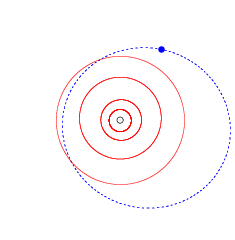(15788) 1993 SB
|
| |
| Discovery[1] | |
|---|---|
| Discovered by |
Iwan P. Williams, Alan Fitzsimmons, and Donal O'Ceallaigh La Palma (950) |
| Discovery date | September 16, 1993 |
| Designations | |
| none | |
| Plutino[2][3] | |
| Orbital characteristics | |
| Epoch March 6, 2006 (JD 2453800.5) | |
| Aphelion | 7,715.1 Gm (51.572 AU) |
| Perihelion | 3,997.1 Gm (26.719 AU) |
| 5,856.2 Gm (39.146 AU) | |
| Eccentricity | 0.317 |
| 89,461 d (244.93 a) | |
Average orbital speed | 4.64 km/s |
| 335.2° | |
| Inclination | 1.9° |
| 354.9° | |
| 79.5° | |
| Physical characteristics | |
| Dimensions | 130? km |
| Mass | ~2×1018 kg |
Mean density | 2.0? g/cm³ |
| ~0.04 m/s² | |
| ~0.07 km/s | |
Sidereal rotation period | ? d |
| Albedo | 0.09? |
| Temperature | ~44 K |
Spectral type | ? |
| 7.7 | |
|
| |
(15788) 1993 SB is a trans-Neptunian object of the plutino class. Apart from Pluto, it was one of the first such objects discovered (beaten by two days by (385185) 1993 RO and by one day by 1993 RP), and the first to have an orbit calculated well enough to receive a number.[2] The discovery was made in 1993 at the La Palma Observatory with the Isaac Newton Telescope. Very little is known about the object. Even the diameter estimate of ~130 km is based on an assumed albedo of 0.09.[4]
References
- ↑ "MPEC 1993-S09: 1993 SB". IAU Minor Planet Center. 1993-09-22. Retrieved 2010-02-20.
- ↑ 2.0 2.1 "MPEC 2010-B62 :Distant Minor Planets (2010 FEB. 13.0 TT)". Minor Planet Center. 2010-01-30. Retrieved 2010-02-20.
- ↑ Marc W. Buie. "Orbit Fit and Astrometric record for 15788" (1999-11-10 using 45 of 50 observations). SwRI (Space Science Department). Retrieved 2010-02-20.
- ↑ Wm. Robert Johnston. "List of Known Trans-Neptunian Objects". Johnston's Archive. Archived from the original on 24 November 2005. Retrieved 2006-02-07.
External links
- MPEC: recovery of the object
- list of known TNOs, including size estimates
- IAU minor planet lists
- Orbital simulation from JPL (Java) / Ephemeris
| ||||||
| ||||||||||||||
| ||||||||||||||||||||||||||||
